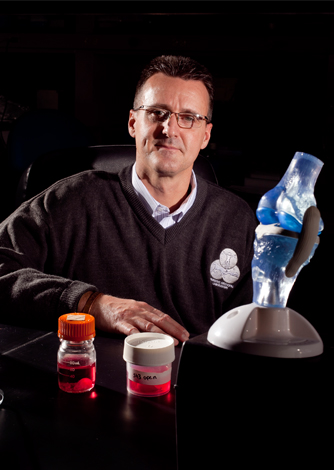
Jimi Cook, director of the Comparative Orthopaedic Laboratory, spends about 15 hours a year documenting and reporting his potential conflicts of interest. Photo by Rob Hill.
In the 10 years that Jennifer May has been director of Conflict of Interest in the Office of Research, Graduate Studies and Economic Development, she has told only one person no — and it was really more like try again. In the end, they found a solution that worked for the faculty member and the university. With about 1,300 reports of possible conflicts of interest a year, that’s an impressive record.
A conflict of interest is any outside activity that might hinder an employee’s ability to complete his or her commitments to the university. That could be as simple as a staff member who occasionally consults with an external entity or as complex as a faculty member who is CEO of a company.
Every year, MU employees must disclose outside employment or business activities and interests that could interfere with their regular duties or represent a conflict of interest. Additionally, faculty and exempt staff must disclose consulting activities outside the university. To disclose, employees need to visit eCompliance.missouri.edu (you will be asked to log in) and complete the Outside Interest Disclosure Form.
When a conflict of interest arises, May’s job is to work with employees to manage their various interests to reduce and eliminate potential risks.
“The process we have is not intended to be punitive,” May said. “We want to encourage these activities. It’s important for our faculty and staff to get out in the community not only for our outreach mission but also for our economic development mission, too.”
When Jimi Cook, the William and Kathryn Allen Distinguished Professor in Orthopaedic Surgery, arrived at MU in 1995, he was assisting with veterinary surgical cases in other states. Currently, Cook, the director of the Comparative Orthopaedic Laboratory, is a consultant with Arthrex, an orthopedic medical device company. Cook also serves on Arthrex’s speakers’ bureau and receives patent royalties from the company. Additionally, he consults with other companies, serves on an orthopedic foundation’s board of trustees and on several journals’ editorial boards, and has numerous patents through the University of Missouri.
Throughout the year, Cook works with May and the Conflict of Interest Committee to manage his potential conflicts by documenting time spent on external projects, disclosing all conflicts appropriately, and assuring that he's using personal time when working on the outside projects.
“People might think of [the committee] as the police, but I think of them as my guardian,” Cook said. “They’re protecting me and trying to find ways for me to do what I need to do to be productive in my career but to make sure I do it right.”
Cook estimates he spends about 15 hours a year documenting and reporting his potential conflicts. “Now, even if it might not be a true conflict of interest, I just report everything,” Cook said. “That way I can easily sleep at night.”
A conflict of interest is a normal part of a university setting. If a conflict is not addressed, the sanction is disciplinary action as determined by the employee’s supervisor. However, nine times out of 10, it’s simply an oversight, and May uses it as an opportunity to educate the employee on the university’s policies.
“Don’t be afraid of the process,” May said. “Yes, there are forms to fill out, but it’s designed to be a process that protects the employee and the university.”
— Kelsey Allen